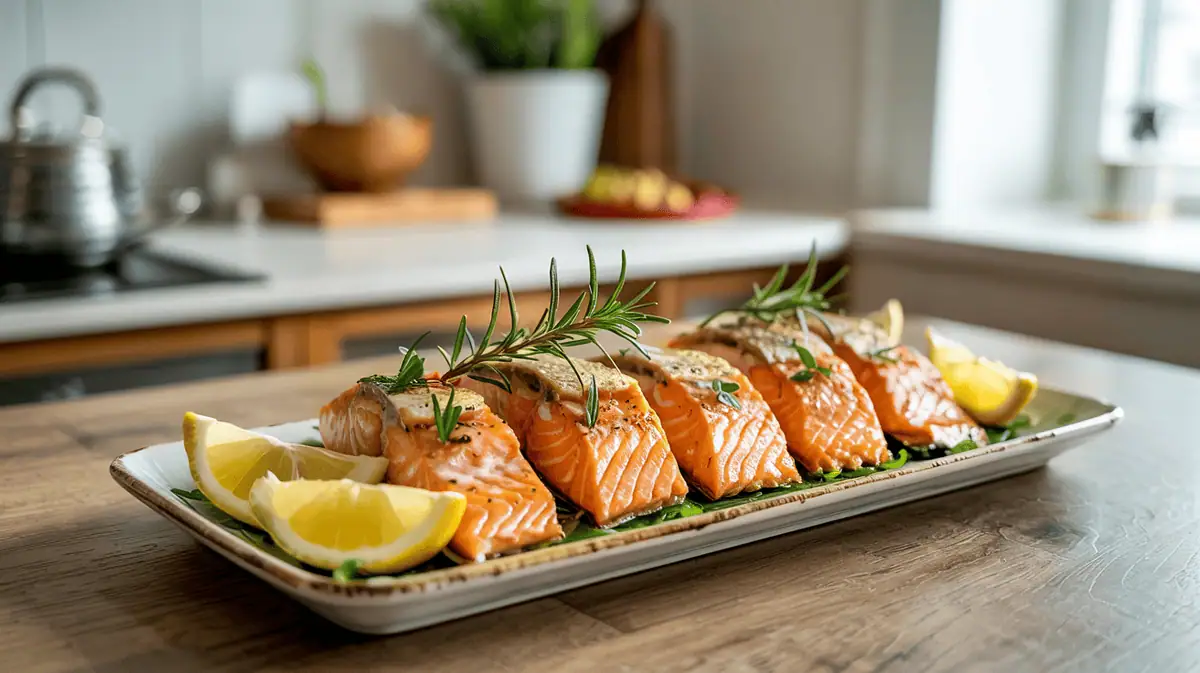Frozen Salmon in Air Fryer – Quick, Easy & Perfect Every Time!
Why Cook Frozen Salmon in the Air Fryer?
Cooking frozen salmon in air fryer has become a favorite technique for home cooks who value speed, simplicity, and consistent results. Unlike traditional methods, it allows you to cook salmon directly from the freezer without sacrificing texture or taste. In this section, we’ll explore the top reasons why this method works so well—starting with one of its most convenient advantages.
No Thawing Required – Straight from Freezer to Plate
One of the greatest time-savers in modern cooking is eliminating the thawing process altogether. With the air fryer, you can skip defrosting entirely. Instead of waiting hours for your salmon to thaw in the fridge or rushing the process in the microwave (often with uneven results), you simply place the frozen fillets directly in the basket.
This method is not only faster—it’s also more consistent. Since the air fryer uses rapid air circulation, the fish begins to cook evenly from the start, producing a moist interior with minimal prep. For busy evenings, this means going from freezer to plate in under 20 minutes with zero planning ahead.
Faster Than Oven or Skillet
One of the biggest advantages of preparing frozen salmon in air fryer is the significant time savings compared to traditional methods. Baking salmon in the oven often requires preheating, plus 20 to 25 minutes of cook time. Cooking it on the stovetop involves close monitoring and can result in uneven doneness—especially when starting from frozen.
In contrast, the air fryer preheats in just a few minutes and cooks frozen salmon in about 12 to 15 minutes. There’s no need to hover or stir. Just place the fillets in the basket, set the timer, and let the device do the work. This hands-off method makes it perfect for busy weeknights or multitasking in the kitchen.
Additionally, cleanup is quicker. With minimal oil and a compact, easy-to-clean basket, the air fryer keeps post-meal chores to a minimum—something the oven and skillet can’t always promise.
Perfect Texture – Crispy Edges, Juicy Inside
Despite its speed and simplicity, cooking frozen salmon in air fryer delivers excellent texture—something often hard to achieve with frozen fish. The air fryer’s rapid heat circulation creates the ideal cooking environment: high, even heat that crisps the outer layer while locking in internal moisture.
As a result, you get salmon that’s golden and slightly crispy on the outside, yet flaky, tender, and juicy inside. Unlike microwaving or boiling, which can make frozen salmon rubbery or mushy, air frying maintains the structural integrity of the fillet.
This balance of textures is why many home cooks prefer the air fryer over traditional methods. Whether served with grains, vegetables, or salads, the satisfying mouthfeel of perfectly cooked air-fried salmon elevates even the simplest meals.
Ingredients You’ll Need for Frozen Salmon in Air Fryer
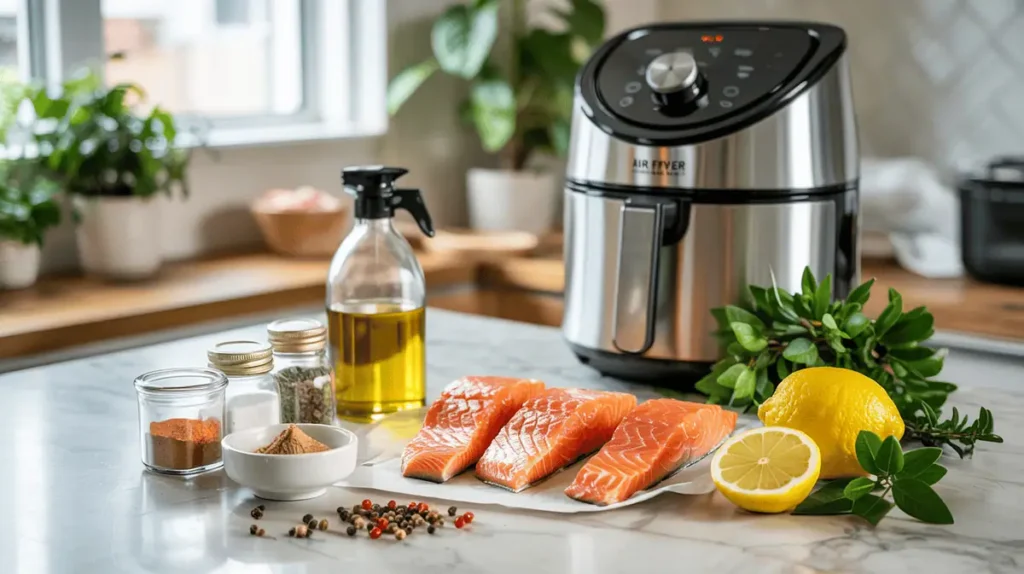
Before you begin cooking frozen salmon in air fryer, it’s important to gather a few key ingredients. The beauty of this recipe lies in its simplicity—just a handful of quality components can deliver a flavorful and nutritious result. In the following sections, we’ll break down what you need, from the salmon itself to the seasonings and oil that elevate the texture and taste.
Frozen Salmon Fillets
The foundation of any good frozen salmon in air fryer recipe is, of course, the salmon itself. Choose fillets that are individually vacuum-sealed and of consistent thickness. Wild-caught salmon delivers a rich, bold flavor, while farm-raised options offer a milder, buttery texture. Both are suitable for air frying. Whenever possible, go for skin-on fillets to help retain moisture and structure during cooking.
If you’re looking for ways to build a satisfying, protein-rich meal around your fillets, consider pairing them with options like our Keto Avocado Egg Salad. It’s a creamy, low-carb side that complements the salmon’s natural richness.
Seasonings and Marinades (Optional but Flavorful!)
While frozen salmon in air fryer can be delicious with just salt and pepper, using the right seasonings or marinades can elevate the flavor significantly. Dry spices are easy to apply even when the salmon is still frozen, making them perfect for quick prep.
Popular choices include garlic powder, onion powder, smoked paprika, dried dill, and lemon zest. These ingredients enhance the fish’s natural taste without overpowering it. For a slightly spicy profile, a pinch of cayenne or chili flakes works well.
If you have a few extra minutes, brushing on a marinade midway through cooking adds even more flavor. Teriyaki, lemon-garlic, or maple-soy blends work beautifully and create a light glaze on the surface. Just be sure not to overload the air fryer with too much liquid, which can affect cooking performance.
For inspiration, our Smoked Salmon Bagel Recipe showcases how even subtle flavor additions can transform a simple protein into something memorable. The same principle applies here—small tweaks go a long way in flavor development.
Oil Spray or Cooking Spray
To achieve a crisp, golden exterior when cooking frozen salmon in air fryer, a light coating of oil is essential. While the air fryer reduces the need for excess fat, using just a small amount of oil improves both texture and appearance.
Avocado oil and olive oil are excellent options due to their high smoke points and neutral flavor. Apply a light spray directly to the fillets before cooking, and optionally to the air fryer basket to prevent sticking. This step also helps seasonings adhere more effectively.
Avoid heavy oils or butter substitutes, which can burn or create unwanted smoke in the air fryer. For ease and even distribution, use an oil mister or non-aerosol spray bottle. This simple addition ensures that your frozen salmon in air fryer comes out crisp on the outside and juicy on the inside—without extra calories or mess.
How to Cook Frozen Salmon in Air Fryer
ooking frozen salmon in air fryer is not only fast—it’s also remarkably foolproof when done correctly. While the process is simple, understanding each step ensures that the salmon cooks evenly, stays moist, and develops the ideal texture. In this section, we’ll walk through a detailed breakdown of the cooking process, including timing, temperature, and practical tips to get perfect results every time.
Step-by-Step Instructions
Cooking frozen salmon in air fryer requires only a few simple steps, but attention to detail ensures perfect results. Start by preheating your air fryer to 390°F. While some models skip this step, preheating ensures even heat distribution from the start. If your salmon fillets are stuck together, rinse them briefly under cold water and pat dry.
Lightly spray the fillets with oil and season both sides. Place them skin-side down in the air fryer basket, ensuring they’re not touching. Cook for 12 to 15 minutes, depending on thickness. The salmon is done when it flakes easily with a fork and reaches an internal temperature of 145°F.
This same approach is used in our Frozen Burgers in the Air Fryer, which also emphasizes spacing, flipping, and monitoring for doneness—principles that apply perfectly to frozen salmon.
Best Temperature and Time Settings
Air fryers vary slightly by brand, but 390°F is a reliable starting point. For average-sized salmon fillets, 12 to 15 minutes yields a well-cooked center and crispy edges. Thicker fillets may need up to 16 minutes. Always use a food thermometer to confirm the internal temperature reaches 145°F.
For additional guidance, consult this helpful resource:
Best Air Fryer Temperature and Time Settings for Fish
Tips for Even Cooking
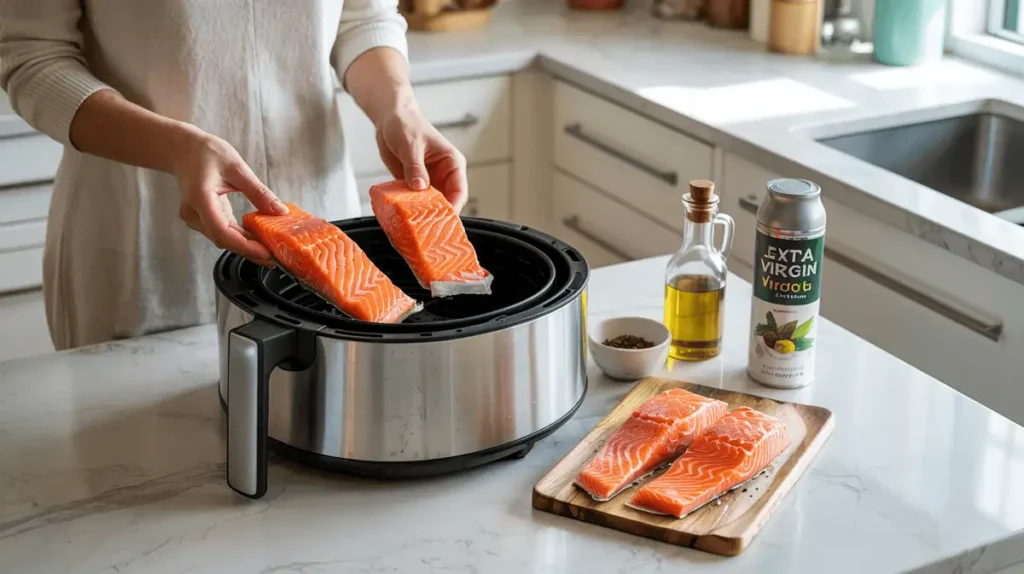
Spacing is key to achieving even results. Don’t overcrowd the basket—air needs to circulate freely around each fillet. Use tongs to flip or adjust positioning if needed halfway through the cooking cycle.
To master air flow and positioning, refer to our Air Fryer French Fries Guide, which also relies on proper spacing and timing for crispiness and consistency.
By following these tips, your frozen salmon in air fryer will be evenly cooked, flavorful, and ready in minutes.
Flavor Variations & Serving Ideas for Frozen Salmon in Air Fryer
One of the best features of cooking frozen salmon in air fryer is its versatility. With just a few adjustments to your seasonings or finishing touches, you can transform the same base protein into entirely different dishes. From fresh, citrusy profiles to bold, spicy flavors, the options are endless. In this section, we’ll explore some of the most popular variations and offer ideas for balanced, delicious sides to complete your meal.
Lemon Garlic Salmon

For a bright, classic flavor, coat your frozen salmon in air fryer fillets with olive oil, garlic powder, lemon zest, and a pinch of salt. Cook as usual, and finish with a squeeze of fresh lemon juice after air frying. This combination enhances the natural richness of the fish without overpowering it. It’s a simple way to keep the dish light and refreshing, especially when paired with a side like our Quick & Easy Salad Recipes.
Teriyaki Glazed Salmon
For a sweet and savory twist, teriyaki-glazed frozen salmon in air fryer is a simple yet flavorful option. Start by cooking the salmon as usual for about 8 to 10 minutes. Then, brush a thin layer of teriyaki sauce over the fillets and return them to the air fryer for the remaining 3 to 5 minutes. The sauce will caramelize slightly, creating a glossy coating and rich flavor profile.
You can use a homemade marinade or a low-sodium bottled version, but be sure not to oversaturate the fillet—too much liquid may cause burning or dripping during air frying. Garnish with sesame seeds, sliced scallions, or a sprinkle of chili flakes to add contrast and texture.
For more inspiration on how to flavor your salmon, check out Healthy Salmon Marinade Ideas , which include low-sugar and low-sodium variations that pair well with air frying.
This teriyaki version works beautifully when served over steamed rice, quinoa, or a vegetable stir-fry. It’s an easy way to bring an Asian-inspired touch to your weeknight meals without the need for a wok or stove.
Cajun-Style Air Fryer Salmon
If you enjoy bold, spicy flavors, Cajun-style frozen salmon in air fryer is an excellent choice. The robust blend of paprika, garlic powder, onion powder, thyme, cayenne pepper, and black pepper adds depth and warmth to each bite. Apply the seasoning mix directly onto the frozen fillets before cooking to allow the spices to form a flavorful crust.
For best results, lightly coat the salmon with oil spray first. This helps the spices adhere properly and promotes even browning. Cook at 390°F for 12 to 15 minutes, depending on thickness, and avoid flipping to preserve the spice layer on top.
Serve your Cajun salmon with cooling side dishes like cucumber salad, avocado slices, or a dollop of Greek yogurt for balance. You can also plate it with roasted sweet potatoes or a grain bowl to create a satisfying, spicy-sweet combination that works well for lunch or dinner.
This variation is ideal when you want to add some variety to your air fryer rotation without extra prep or complex ingredients.
Best Sides to Serve With Frozen Salmon in Air Fryer
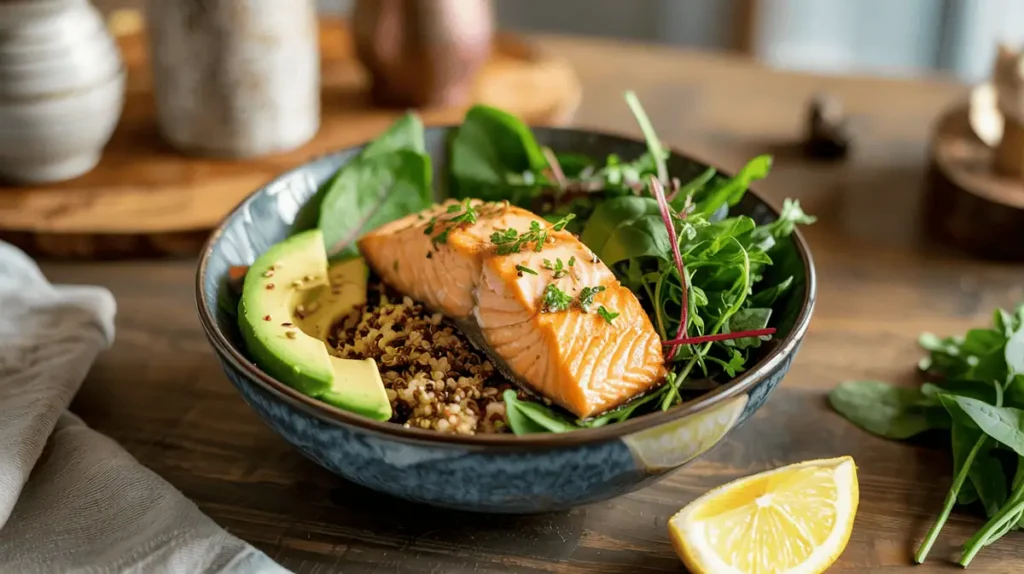
One of the strengths of frozen salmon in air fryer is its versatility when it comes to side dishes. You can keep it light or build a more filling plate, depending on the occasion.
For a fresh, balanced option, serve the salmon with leafy greens, cherry tomatoes, cucumber slices, and a lemon vinaigrette. This combination keeps the meal low in carbs and high in nutrients.
If you’re craving something heartier, go with quinoa, brown rice, or roasted baby potatoes. These sides add texture and make the dish feel more complete without overpowering the salmon’s flavor.
For a colorful and nutrient-rich bowl, pair your salmon with steamed broccoli, shredded carrots, and a spoonful of hummus or avocado. This works well for meal prep too, as everything holds up well in storage.
For inspiration, try building a plate similar to our Ultimate Poke Bowl Recipe. It combines protein, grains, and raw veggies in a way that feels satisfying and fresh.
No matter your choice, the key is to balance the richness of the salmon with contrasting textures and flavors. Keep it simple, and let the quality of your frozen salmon in air fryer shine through.
Common Mistakes to Avoid When Cooking Frozen Salmon in Air Fryer
Although cooking frozen salmon in air fryer is a straightforward process, there are a few common mistakes that can lead to disappointing results. Whether you’re new to air frying or have used it many times, these errors can still happen. Understanding what to avoid ensures that your salmon stays moist, flavorful, and perfectly cooked every time. Let’s go over the most frequent pitfalls and how to fix them.
Overcooking the Salmon
A frequent mistake when preparing frozen salmon in air fryer is overcooking. Because fillet thickness can vary, relying solely on a timer can lead to dry, tough results. Instead, monitor the salmon closely toward the end of the cooking cycle to avoid passing the ideal point.
The fish is fully cooked when it flakes easily with a fork and reaches an internal temperature of 145°F. Depending on your air fryer model, that sweet spot usually happens between 12 and 15 minutes. For thinner fillets, check for doneness after 10 minutes. For thicker cuts, rotate or reposition them halfway through to ensure even cooking.
A helpful way to develop confidence in air frying salmon is by practicing with simpler proteins. For instance, our Frozen Burgers in the Air Fryer recipe follows a similar temperature-based method, helping you get familiar with visual and textural cues.
If you’re still uncertain or have had inconsistent results in the past, don’t worry. You’re not alone. Many home cooks face this learning curve with air fryers. For additional guidance, check out Top Air Fryer Mistakes and How to Fix Them , a resource that walks through the most common errors—including overcooking—and how to prevent them.
Mastering the right timing is essential for perfect salmon. Once you get it right, you’ll enjoy juicy, flaky fish with every batch—no guesswork required.
Not Preheating the Air Fryer
Many home cooks skip the preheating step, thinking it’s unnecessary. However, not preheating the air fryer can lead to uneven results. The cooking process is more effective when the basket is already hot. It helps the salmon begin cooking immediately and ensures a crisp finish.
Without preheating, the fish may dry out on the edges before the center reaches a safe temperature. This small step improves both texture and timing.
To preheat, set your air fryer to 390°F and let it run empty for 3 to 5 minutes. Once ready, place the salmon fillets inside, skin-side down if applicable. This method creates a sear effect similar to preheated pans but with far less effort.
Taking time to preheat your air fryer results in a better-cooked frozen salmon in air fryer—crispy outside, moist inside, and evenly done.
Skipping the Oil Spray
It may seem like a small detail, but skipping the oil spray can impact both the texture and appearance of your frozen salmon in air fryer. Even though air fryers require less oil than other cooking methods, a light mist helps create that perfect golden crust.
Without oil, the salmon can dry out or stick to the basket. It may also cook unevenly, especially if the surface is bare. Applying a quick spray of olive oil or avocado oil over the fillet and basket prevents this and enhances browning.
You don’t need much—just enough to coat the surface. This step also helps your seasonings stick better, boosting flavor in every bite. It’s a small action that makes a big difference in the final result.
Skipping the oil spray is one of the easiest mistakes to fix, and once corrected, you’ll notice the improvement immediately. Your frozen salmon in air fryer will look better, taste better, and have a restaurant-quality finish right from your kitchen.
Nutrition Information
In addition to being fast and easy, cooking frozen salmon in air fryer is also a smart nutritional choice. This method preserves the fish’s natural health benefits while minimizing the need for added fats or heavy sauces. In the sections below, we’ll break down the key macronutrients per serving and explore why air-fried salmon aligns with a variety of healthy eating plans.
Calories and Macronutrients per Serving
A standard serving of frozen salmon in air fryer—about 4 to 6 ounces—provides an excellent balance of protein and healthy fats with minimal carbohydrates. On average, one fillet contains approximately 200 to 250 calories, 20 to 25 grams of protein, and 10 to 15 grams of fat, depending on the salmon variety and whether the skin is included.
These numbers make air-fried salmon an ideal option for low-carb, high-protein, or ketogenic diets. Unlike breaded or battered alternatives, this method keeps added calories to a minimum by using just a light mist of oil. Pairing the salmon with leafy greens, steamed vegetables, or a light grain adds fiber and micronutrients without compromising its nutritional value.
Is Frozen Salmon in Air Fryer a Healthy Option?
Yes, cooking frozen salmon in air fryer is a healthy option that fits many diets. This method keeps the fish low in added fat and free from heavy sauces. It’s ideal for balanced eating, including low-carb, keto, and heart-healthy plans.
Salmon is naturally rich in omega-3 fatty acids. These healthy fats support brain function, reduce inflammation, and promote cardiovascular health. Air frying preserves these benefits without adding unnecessary oils.
Since you cook the fillet without breading or batter, the calorie count stays low. Using only a light spray of oil keeps it crisp without sacrificing nutrition. The result is a clean, protein-rich meal packed with essential nutrients like vitamin D, selenium, and B vitamins.
In short, air-fried salmon offers convenience without compromising health. It’s a smart choice for those seeking quick, nutritious meals with simple ingredients.
Storage and Reheating Tips
Proper storage and reheating techniques help extend the life of your meal while preserving flavor and texture. After cooking frozen salmon in air fryer, knowing how to handle leftovers safely ensures that they remain both delicious and nutritious. Below, we’ll explore how to store cooked salmon effectively and the best way to reheat it without drying it out.
How to Store Leftovers
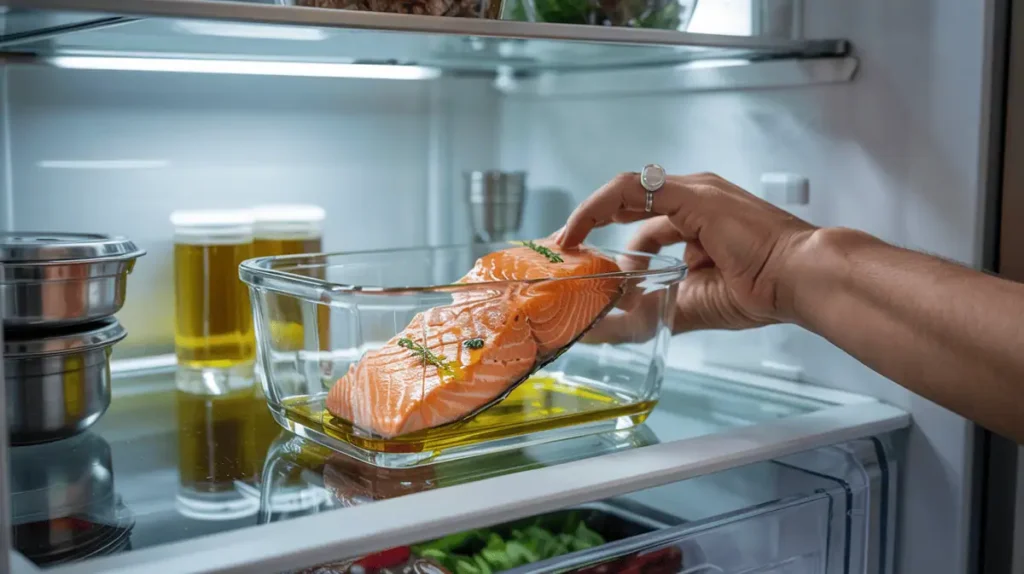
If you have leftover frozen salmon in air fryer, it’s essential to store it correctly to maintain freshness and safety. First, let the salmon cool completely at room temperature—this typically takes 10 to 15 minutes. Then, transfer the fillets into an airtight container or wrap them tightly in foil or parchment paper. Place the wrapped salmon in the refrigerator and consume it within 3 days for best quality.
If you’re planning to store it longer, freezing is a safe option. Use freezer-safe bags or containers, and remove as much air as possible before sealing. Label with the date, and use within one month for optimal taste and texture. When reheating frozen leftovers, always thaw them overnight in the fridge before reheating.
Reheating in the Air Fryer Without Drying Out
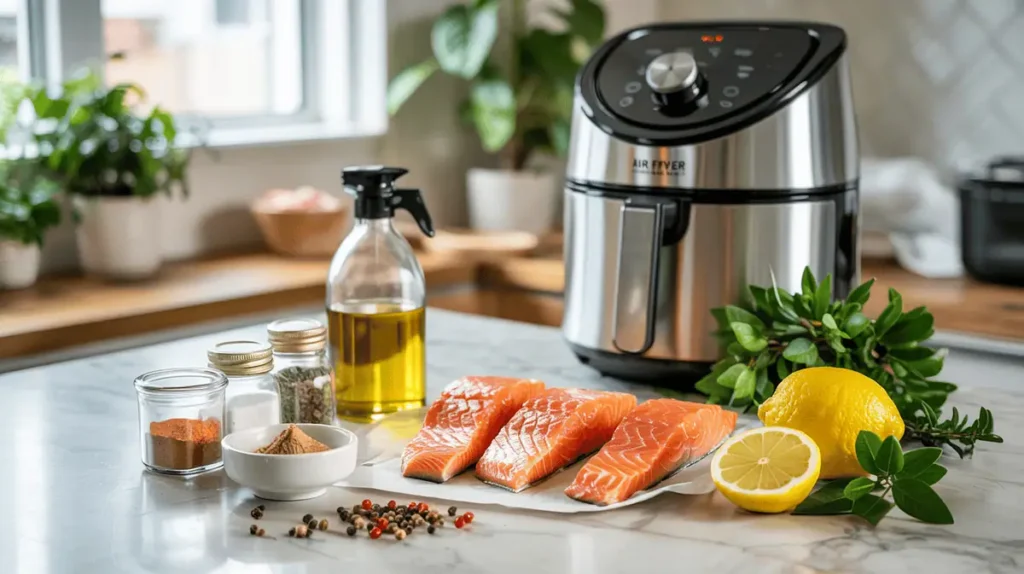
Reheating leftover frozen salmon in air fryer is quick, but requires care to maintain texture and moisture. If done incorrectly, the salmon can become dry or overcooked. With the right method, however, you can enjoy a result nearly as good as when freshly made.
Start by preheating your air fryer to 350°F. Place the salmon in the basket, skin-side down if applicable. To retain moisture, cover it loosely with a piece of foil. Reheat for 4 to 6 minutes, depending on thickness. Check the center to ensure it’s warmed through.
Avoid using higher temperatures, which can cause the outer layer to dry out before the inside heats up. You can also add a splash of lemon juice or a tiny bit of oil before reheating. This helps rehydrate the fillet and enhances the flavor.
Only reheat what you’ll eat right away. Repeated reheating affects both texture and quality. When stored and warmed correctly, leftover frozen salmon in air fryer stays tender, flaky, and ready to serve again—without waste or compromise.
Conclusion
Mastering the frozen salmon in air fryer method unlocks a fast, reliable, and healthy way to prepare a satisfying meal any day of the week. This technique simplifies dinner routines by eliminating the thawing step and significantly reducing prep time. Whether you’re cooking for one or planning meals for the whole family, the process remains consistent, efficient, and flavor-rich.
Unlike traditional methods that require careful monitoring or extended baking time, air frying delivers even results in under 20 minutes. The salmon stays moist on the inside while developing a lightly crisp surface—qualities often difficult to achieve when cooking from frozen.
Versatility is another major benefit. With just a few ingredients, you can adjust the flavor to match your preferences or dietary needs. From lemon garlic simplicity to bold Cajun spice or teriyaki glaze, your seasoning choices can transform the same base protein into multiple meals. Serving options are just as flexible—salads, grains, vegetables, or bowls all work beautifully.
More importantly, this method supports a balanced lifestyle. With minimal oil and retained nutrients like omega-3s and lean protein, air-fried salmon makes it easy to eat well without sacrificing taste or time.
Now that you know exactly how to cook frozen salmon in air fryer—from ingredients to storage—it’s time to put this method into practice. Whether for busy weeknights or weekend meal prep, it’s a kitchen strategy worth mastering.
FAQs About Frozen Salmon in Air Fryer
After reviewing the full process for cooking frozen salmon in air fryer, you might still have a few questions—especially if it’s your first time using this method. Below are answers to some of the most frequently asked questions to help you feel confident every step of the way, from freezer to plate.
Can you really cook frozen salmon in the air fryer without thawing it first?
Yes, absolutely. One of the main advantages of using the air fryer is that you can cook salmon straight from the freezer—no thawing required. This saves time and reduces planning. As long as the fillets are not stuck together and are properly seasoned, frozen salmon in air fryer will cook evenly and remain juicy.
How do I know when the salmon is fully cooked?
To ensure your frozen salmon in air fryer is fully cooked, use a food thermometer to check the internal temperature. The USDA recommends a minimum internal temperature of 145°F (63°C). At this point, the salmon should appear opaque throughout and flake easily with a fork.
Visual cues also help: the flesh should change from translucent to solid pink, and there should be no raw spots in the center. If you’re unsure, gently press the fillet—if it breaks apart into moist flakes, it’s done. Be cautious not to overcook it, as that can cause dryness and reduce flavor.
What temperature should I use to cook frozen salmon in the air fryer?
For best results, cook frozen salmon in air fryer at 390°F (200°C). This temperature allows the hot air to quickly crisp the outside of the fillet while ensuring the interior cooks evenly and thoroughly.
If your salmon is especially thick, you can add 1 to 2 extra minutes to the total cook time, but avoid raising the temperature above 400°F, as this may lead to a dry or overcooked texture. Keeping the temperature consistent and using a preheated air fryer helps produce a moist, flavorful result with a slightly crisp surface—perfect for everyday meals.
Can I use foil or parchment paper in the air fryer when cooking frozen salmon?
Yes, you can use foil or parchment paper when cooking frozen salmon in air fryer, but there are a few important guidelines to follow. First, always check your air fryer manufacturer’s instructions—some models advise against using liners that can block airflow.
If allowed, foil or parchment can help minimize mess and make cleanup easier. Just be sure to leave enough space around the edges so that hot air can circulate properly. Never cover the entire basket or block the vents.
Using parchment or foil also helps retain moisture and prevents delicate skin from sticking to the basket. This can be especially useful if you’re cooking with glazes or marinades that might otherwise drip and burn.
.

